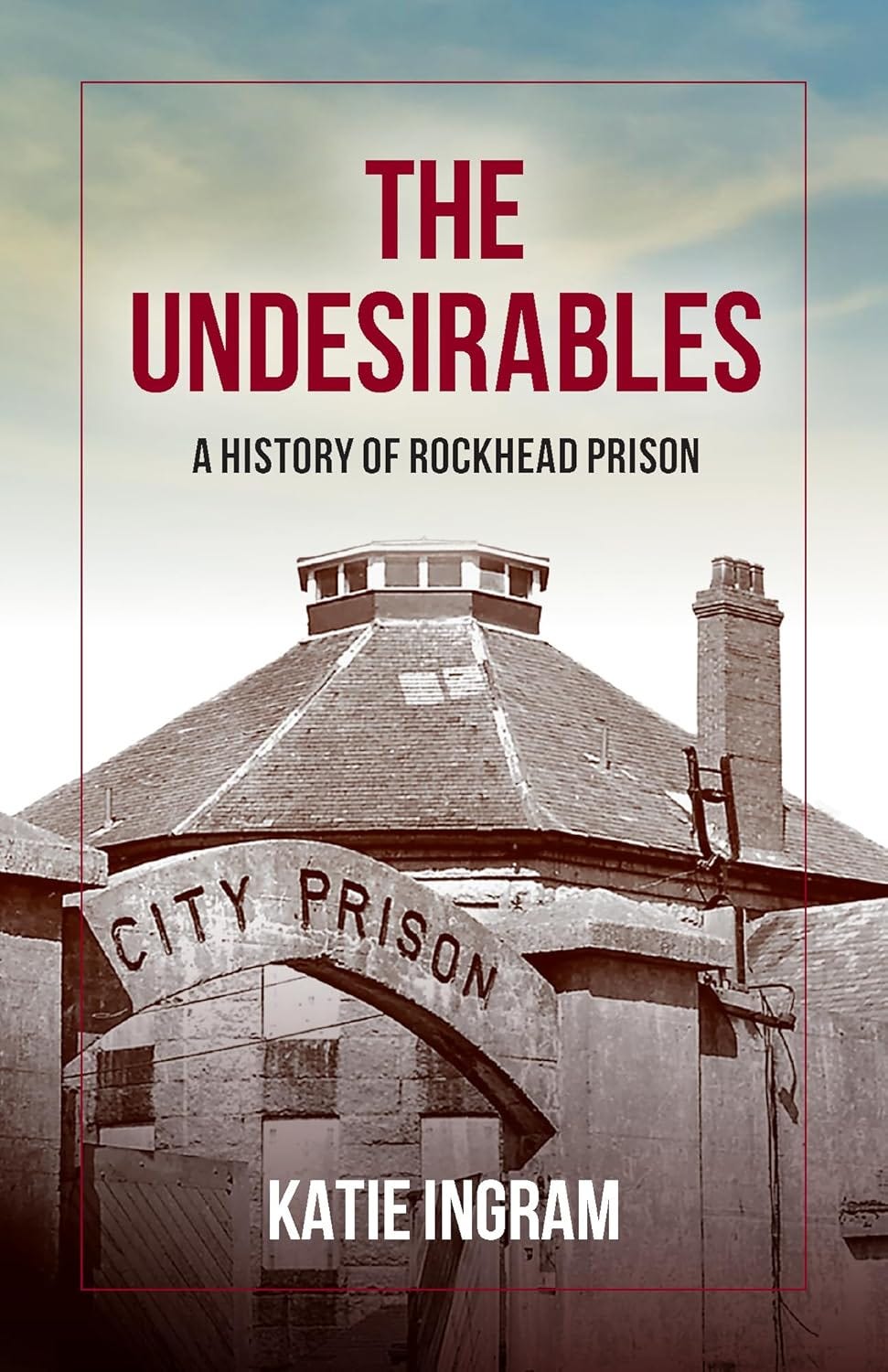The Undesirables: A History of Rockhead Prison by Katie Ingram
A review and five questions for the author
Growing up in Kingston Ontario, I was no stranger to having prisons within (and without) the city limits. We had the infamous Kingston Penitentiary (AKA “The Pen”) and The Prison for Women (P4W) within a stone’s throw of each other. Both are now decommissioned as prisons.
However, unlike Rockhead prison in Halifax, both of the former building still stand. Rockhead was torn down in the 1970s and only a few photos remain. Fortunately, we now have Katie Ingram’s latest book, The Undesirables which uncovers, not only facts about the building itself, but what little is known of its inmates, escapes, and correctional personnel employed there.
Written in a clear, engaging style, the reader gets a look at the archaic “correctional” measures of the time period (basically, breaking rocks for the men, domestic chores for the women).
One typically thinks of prisons as holding murderers, thieves, and other violent criminals.Times were different in the early days of Halifax, it seems. I found it amusing to read of the crimes of the day back in the late 1800s-early 1900s: public drunkenness, vagrancy, public nuisances, and so on. These were the ones thrown into Rockhead for days, weeks, or months, depending on the crime and what the judge of the day felt like doling out, it seems. Take the case of Ellen Reardon, for example:
"Few women have led a harder life than this same Ellen Reardon," said The Halifax Herald article in 1899. But for Rockhead, where she spends most of her time, she would be dead."
Most of the time Ellen, who was described in the Rockhead inmate ledger as having black hair and black eyes, was arrested for drunkenness or causing a disruption related to being drunk. In 1864, the then thirty-two-year old was arrested for being drunk, disorderly and using profane language. She was given thirty days. In 1893 she was arrested for being drunk and disorderly on the street and sentenced to six months, while in 1897 she was arrested in August on two charges: public drunkenness, for which she was sentenced to fifteen days, and for "no visible means of support," for which she was given three months. In 1906, with her hands covered in blood from broken glass, she was arrested for breaking into a shop on the corner of Albemarle and Prince Streets in Halifax's downtown.”
Rockhead even incarcerated children(!) for a time, believe it or not. Here’s the case of eight-year-old Henry Cassidy, arrested for public drunkenness:
“By the time Henry was sentenced, Rockhead had a juvenile section, which was added in 1864. Just a year earlier, in 1863, the Morning Sun noted how such a place was necessary to successfully rehabilitate child inmates. At the time, they were "either sent to Rockhead to learn more mischief from old sinners, or still left at large to annoyance of a communıty, the reproach and scandal of our municipal government and their own sure destruction."
Clearly, Katie Ingram researched Rockhead thoroughly and has pored over many old newspaper archives to assemble this fascinating history of this little-known part of Halifax’s history.
Five Questions for Katie Ingram
1.Where did the initial idea to research and write a book on Rockhead come from?
Like a lot of people who didn't grow up with Rockhead and/or aren't originally from Halifax I probably first saw the name on the wine and beer store in the North End. I'm not sure how long ago that was, but in 2016 or 2017 I wrote an article for Halifax Magazine about many of Halifax's historic prisons, which included Rockhead. I found it so interesting that there was this prison, right in the middle of the former city, that I had to look into it more. There were a few books that mentioned it, some more than others like Judith Fingard's The Dark Side of Life in Victorian Halifax and Michael Boudreau's City of Order, but nothing that was just about Rockhead. So I decided I was the person to do it.
2. From start to finish, how much time was invested in writing Rockhead?
It took a long time. It took about eight years from idea to publication. I started my research in 2017, but I could only do bits and pieces here and there due to other work commitments early on since research can take a while. From 2019 to 2023, I ended up working on another project that would have included Rockhead on a smaller scale. When that fell through in 2023, I made it my mission to get the Rockhead book done, so I spent a lot of time writing and finishing up the last of my research throughout 2023 and 2024.
3. What were some challenges in doing the research? Was it more difficult than you imagined?
I wouldn't say the research was more difficult than I had imagined, as any historical research takes time, but finding time was an issue. The records were all there, they just needed to be sifted through. Most of the Rockhead records (like governor's reports and prison registers) are at the Halifax Municipal Archives, which are a bit of a trek for me, and because I'm also working, I needed to make sure I put aside time which can be hard. Then another issue came up when we were locked down during COVID and I couldn't get to the files I needed to so I was at a standstill for a few months there.
4. There are some photos included in the book, but only the photo of the archway of Rockhead and some interior photos. It must have proved difficult to get images of the actual building for the outside.
There are several photos out there, but not a lot of exterior photos. Most of the ones I've seen were taken in the 1960's and show various rooms and interior locations, like cells, hallways and the kitchens. It was quite a large structure, over 180 feet long, so was definitely hard to photograph. Most of the exterior photos show walls, a side view or just one angle of the octagon building and smaller out buildings. The octagon building actually held the governor's residence, which housed him and his family.
5. I found it interesting to read of incarcerating those accused of vagrancy (which is no longer a crime as such), public drunkenness, and for being a public nuisance. One assumes that prisons hold murderers, extortioners, bank robbers, and such. Some of the sentences were arbitrarily applied as well. Perhaps comment on this aspect of a changing society/punishment?
Definitely. I personally feel the Victorians and Edwardians wanted to present this picture perfect world, and if you didn't fit in it they hid or punished you. So, things we couldn't consider crimes today (because we have a better understanding of people and illnesses and also try to have better support in place), were crimes then. And it wasn't just Rockhead. This was a trend with other facilities like the City Home/poor house and Mount Hope Asylum. I could definitely see a lot of the earlier inmates being victims of circumstance, who, with the proper support, would have had better lives.
About the Author
Katie Ingram is Halifax-based writer and journalism instructor. She is also the author of Breaking Disaster: Newspaper Stories of the Halifax Explosion, and despite her love of historic newspapers, she still struggles with the microfilm reader.
About the Reviewer
James M. Fisher is the Editor-in-Chief of The Seaboard Review of Books. He lives in Miramichi New Brunswick with his wife Diane, their Tabby cat Eddie and Buster the Border Collie. James works as an MRI Technologist at the Miramichi Hospital.
Book Details
Publisher : Pottersfield Press
Publication date : Sept. 5 2025
Language : English
Print length : 186 pages
ISBN-10 : 1990770851
ISBN-13 : 978-1990770852





